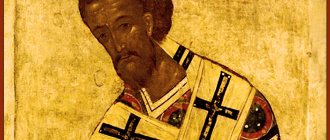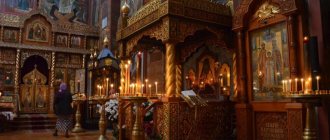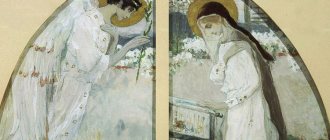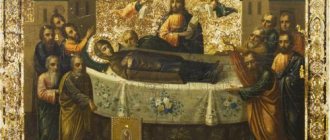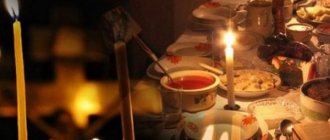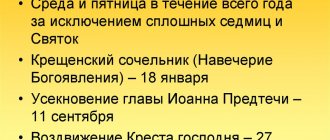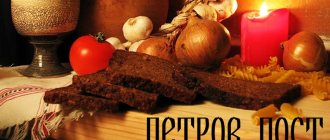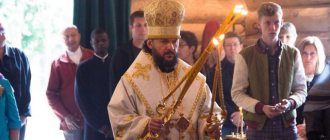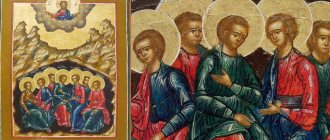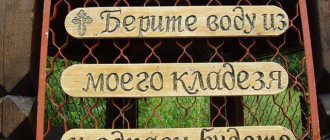| St. Dionysius of Suzdal |
Dionysius of Suzdal
(+ 1385), Metropolitan of Kiev and All Russia, Saint Memory of June 26, October 15, in the Cathedrals of Vladimir, Kiev, Kostroma, Nizhny Novgorod and Radonezh saints
In the world, David was born in the Kiev region at the beginning of the 14th century. From an early age he devoted himself to the exploits of monastic life in the Kiev Pechersk Lavra.
Out of love for solitude, with the blessing of the abbot, Dionysius retired to the north of Russia. On the banks of the Volga, below Nizhny Novgorod, the saint dug himself a cave and settled in it. At first he lived here alone as a hermit, and then, when seekers of silence gathered to him, around 1335, he founded a monastery. With his extensive knowledge of the rules of faith and strict ascetic life, he gained universal respect. Contemporaries saw in him “ a meek, prudent man, knowledgeable of the Holy Scriptures, a teacher, glorious in fasting and filled with love for everyone.”
.»
The Monk Euthymius of Suzdal and the Monk Macarius of Zheltovodsk were brought up under his leadership.
In 1352, he sent 12 people from his brethren to the “ upper cities and countries where God will bless whom”
"for the spiritual enlightenment of the people and the founding of new monasteries.
The monastery of St. Dionysius had a high beneficial influence on the residents of Nizhny Novgorod. In 1371, the saint tonsured the forty-year-old widow of Prince Andrei Konstantinovich into monasticism, following whose example many “ Bolyars” took monasticism: wives, widows, and girls
«.
The princes of Nizhny Novgorod valued his wise advice and instructions, and the Monk Dionysius was personally known to the All-Russian metropolitans.
On February 11, 1374, on the first Sunday of Great Lent (“on Zbor”), he was ordained bishop of Judgment, and Novugorod Nizhny, and Gorodets by Metropolitan Alexy, who personally knew him.
[1].
The years of his priestly service fall at a significant time - Rus' was rising to throw off the Tatar yoke. On March 31, 1375, the Tatar military leader, captured by the residents of Nizhny Novgorod, found himself in the bishop's courtyard and fired an arrow at Saint Dionysius. But the Lord protected His chosen one - the arrow only hit the bishop’s robe. In 1377, with the blessing and, possibly, under the editorship of St. Dionysius, the monk Lavrentiy compiled the famous Laurentian Chronicle, which inspired Rus' in the liberation struggle.
The saint was a zealous fighter for the purity of Orthodoxy. He did a lot in the fight against the Strigolnik heresy.
After the death of St. Alexy, the Venerable Sergius of Radonezh instructed Grand Duke Dimitri Ivanovich Donskoy to elect St. Dionysius to the metropolis. But the Grand Duke wanted to see his favorite, the court priest Mityai (Mikhail), as the metropolitan in Moscow.
In 1379, protecting the honor of the primate see, Saint Dionysius, one of all the bishops gathered in Moscow at the order of the prince, opposed the election of the prince’s protege, the notorious Archimandrite Mitya, as metropolitan. St. Dionysius threatened to tear the tablets from his mantle with his own hands, that is, to deprive him of his rank.
Regarding this discord and for the sake of other church affairs, St. Dionysius planned a trip to Constantinople, to the patriarch. The Grand Duke, at the request of his favorite, decided to prevent this trip and put Dionysius in captivity. Released at the request of St. Sergius of Radonezh and given his bail, St. Dionysius nevertheless fled to Constantinople in the same 1379, despite his promise not to do so. By this, as the chronicler puts it, he caused himself “reproach and indignation,” and his holy guarantor - a lot of troubles and troubles.
The saint made a strong impression on the Greeks with his high spiritual disposition and deep knowledge of the Holy Scriptures. Patriarch Neil, calling the saint “ truly God and a spiritual man”
“, he wrote that he himself saw his “
fasting and almsgiving, and vigil, and prayers, and tears, and all other good things
.” Patriarch Nil honored Saint Dionysius with the rank of archbishop. From Constantinople, Saint Dionysius sent two copies of the Hodegetria icon of the Mother of God and many relics of saints for the cathedrals of Suzdal and Nizhny Novgorod. From the patriarch he brought a letter against the Novgorod Strigolniks and was in Novgorod on the case of these heretics. In 1382 he was already in Suzdal and Nizhny.
Since Dimitry Donskoy was dissatisfied with Metropolitan Pimen, who acquired the rank from the patriarch by deception, after the sudden death of Mityai, now he wanted to see Saint Dionysius as metropolitan in Moscow and for this purpose sent him to Constantinople.
There is reason to believe that Dionysius’s trip was connected with the conclusion of the Moscow-Lithuanian agreement in 1383, according to which the Lithuanian Grand Duke Vladislav (Yagailo) pledged to convert to Orthodoxy and marry the daughter of the Grand Duke Dimitri Donskoy. Obviously, in connection with this agreement, a decision was made to eliminate the division of the Kyiv Metropolis established in 1375 into the Moscow part, which was ruled by Metropolitan Pimen, and the Lithuanian part, headed by Metropolitan Cyprian. It was assumed that Dionysius was to head the reunited all-Russian metropolis.
In 1384, Saint Dionysius was installed by Patriarch Nile as “Metropolitan of Rus'.” But, upon returning to Kyiv, the saint was captured by order of the Kyiv prince Vladimir (Vasily) Olgerdovich, since by this time Jagiello had broken the agreement with Demetrius Donskoy, and the agreement on the occupation of the metropolitan see by Dionysius had also lost force. The Lithuanian princes were dissatisfied that the Prince of Moscow expelled Cyprian from Moscow, who, at the insistence of the Lithuanian Grand Duke Olgerd, was appointed metropolitan of all Rus'. Dionysius was accused of going to Constantinople “without the orders” of the Lithuanian princes [2] and was imprisoned, in which he died on October 15, 1385.
The saint was buried in the Anthony Caves of the Kiev Pechersk Monastery. On June 26, the memory of Saint Dionysius is celebrated for the sake of his namesake with the Monk David of Thessalonica, whose name he bore in the world. In the Synodikon of 1552 of the Nizhny Novgorod Pechersk Monastery, Saint Dionysius is called the “venerable wonderworker.” Mentioned in song 9 of the canon of the Kiev-Pechersk venerable hieromonk Meletius Sirig from 1643.
Troparion
To the zealot of Orthodoxy, to the teacher of piety, / to those seeking salvation, good pilot, / to the monastics, God-inspired adornment, / to the God-bearing Euthymius, interlocutor, to Saint Dionysius, / you have enlightened your fatherland with your teachings and virtues, / do not forget us, who honor you, / but rule our life in peace.
Notes
- Dionysius (Archbishop of Suzdal) // Russian Biographical Dictionary: in 25 volumes. - SPb.-M., 1896-1918.
- ↑ 12
Life of Saint Dionysius - Dionysius, St. Archived November 10, 2007 on the Wayback Machine
- Facial chronicle vault of the 16th century. Russian chronicle history. Book 9. 1373-1380. (undefined)
.
runivers.ru
. Date accessed: February 7, 2022. - Ulyanov O.G.
Guarantee of St. Sergius of Radonezh: incident with the oath to Grand Duke Dmitry Donskoy of Bishop Dionysius of Suzdal Archived copy of March 5, 2010 on the Wayback Machine - Facial chronicle vault of the 16th century. Russian chronicle history. Book 9. 1373-1380. (undefined)
.
runivers.ru
. Date accessed: February 7, 2022. - The same conciliar act also accuses Dionysius, then deceased, of attempting to seize power.
- John Meyendorff.
Byzantium and Muscovite Rus'. Ch. X “Lithuania turns to the West” // History of the Church and Eastern Christian mysticism. — P. 511. - It is noteworthy that in the Moscow chronicle of the late 15th century he is called the Archbishop of Suzdal “in the Metropolitan Polytechnic”. The chronicle reports that he wanted
“to be a metropolitan in Russia.” - Saint Dionysia, Archbishop of Suzdal (+ 1385) // Nun Taisiya. Saints of Russia. Saint Petersburg. Publishing house "Azbuka-classics". 2001
Excerpt characterizing Dionysius (Metropolitan of Kiev)
The main action of the Battle of Borodino took place in the space of a thousand fathoms between Borodin and Bagration’s flushes. (Outside this space, on the one hand, the Russians made a demonstration by Uvarov's cavalry in mid-day; on the other hand, behind Utitsa, there was a clash between Poniatowski and Tuchkov; but these were two separate and weak actions in comparison with what happened in the middle of the battlefield. ) On the field between Borodin and the flushes, near the forest, in an area open and visible from both sides, the main action of the battle took place, in the most simple, ingenuous way. The battle began with a cannonade from both sides from several hundred guns. Then, when the smoke covered the entire field, in this smoke two divisions moved (from the French side) on the right, Dessay and Compana, on fléches, and on the left the regiments of the Viceroy to Borodino. From the Shevardinsky redoubt, on which Napoleon stood, the flashes were at a distance of a mile, and Borodino was more than two miles away in a straight line, and therefore Napoleon could not see what was happening there, especially since the smoke, merging with the fog, hid all terrain. The soldiers of Dessay's division, aimed at the flushes, were visible only until they descended under the ravine that separated them from the flushes. As soon as they descended into the ravine, the smoke of cannon and rifle shots on the flashes became so thick that it covered the entire rise of that side of the ravine. Something black flashed through the smoke - probably people, and sometimes the shine of bayonets. But whether they were moving or standing, whether they were French or Russian, could not be seen from the Shevardinsky redoubt. The sun rose brightly and slanted its rays straight into the face of Napoleon, who was looking from under his hand at the flushes. Smoke lay in front of the flushes, and sometimes it seemed that the smoke was moving, sometimes it seemed that the troops were moving. People's screams could sometimes be heard behind the shots, but it was impossible to know what they were doing there. Napoleon, standing on the mound, looked into the chimney, and through the small circle of the chimney he saw smoke and people, sometimes his own, sometimes Russians; but where what he saw was, he did not know when he looked again with his simple eye. He stepped off the mound and began to walk back and forth in front of him. From time to time he stopped, listened to the shots and peered into the battlefield. Not only from the place below where he stood, not only from the mound on which some of his generals now stood, but also from the very flashes on which were now together and alternately the Russians, the French, the dead, the wounded and the living, frightened or distraught soldiers, it was impossible to understand what was happening in this place. For several hours at this place, amid incessant shooting, rifle and cannon fire, first Russians, sometimes French, sometimes infantry, sometimes cavalry soldiers appeared; appeared, fell, shot, collided, not knowing what to do with each other, screamed and ran back. From the battlefield, his sent adjutants and orderlies of his marshals constantly jumped to Napoleon with reports on the progress of the case; but all these reports were false: both because in the heat of battle it is impossible to say what is happening at a given moment, and because many adjutants did not reach the real place of the battle, but conveyed what they heard from others; and also because while the adjutant was driving through the two or three miles that separated him from Napoleon, circumstances changed and the news he was carrying was already becoming incorrect. So an adjutant galloped up from the Viceroy with the news that Borodino had been occupied and the bridge to Kolocha was in the hands of the French. The adjutant asked Napoleon if he would order the troops to move? Napoleon ordered to line up on the other side and wait; but not only while Napoleon was giving this order, but even when the adjutant had just left Borodino, the bridge had already been recaptured and burned by the Russians, in the very battle in which Pierre took part at the very beginning of the battle. An adjutant who rode up from a flush with a pale, frightened face reported to Napoleon that the attack had been repulsed and that Compan was wounded and Davout was killed, and meanwhile the flushes were occupied by another part of the troops, while the adjutant was told that the French had been repulsed and Davout was alive and only slightly shell-shocked. Taking into account such necessarily false reports, Napoleon made his orders, which either had already been carried out before he made them, or could not and were not carried out. Marshals and generals, who were at a closer distance from the battlefield, but just like Napoleon, did not participate in the battle itself and only occasionally drove into the fire of bullets, without asking Napoleon, made their orders and gave their orders about where and where to shoot, and where to gallop on horseback, and where to run to foot soldiers. But even their orders, just like Napoleon’s orders, were also carried out to the smallest extent and were rarely carried out. For the most part, what came out was the opposite of what they ordered. The soldiers, who were ordered to go forward, were hit by grapeshot and ran back; the soldiers, who were ordered to stand still, suddenly, seeing the Russians suddenly appearing opposite them, sometimes ran back, sometimes rushed forward, and the cavalry galloped without orders to catch up with the fleeing Russians. So, two regiments of cavalry galloped through the Semenovsky ravine and just drove up the mountain, turned around and galloped back at full speed. The infantry soldiers moved in the same way, sometimes running completely different from where they were told. All the orders about where and when to move the guns, when to send foot soldiers to shoot, when to send horse soldiers to trample Russian foot soldiers - all these orders were made by the closest unit commanders who were in the ranks, without even asking Ney, Davout and Murat, not only Napoleon. They were not afraid of punishment for failure to fulfill an order or for an unauthorized order, because in battle it concerns what is most dear to a person - his own life, and sometimes it seems that salvation lies in running back, sometimes in running forward, and these people acted in accordance with the mood of the moment who were in the heat of battle. In essence, all these movements back and forth did not facilitate or change the position of the troops. All their attacks and attacks on each other caused them almost no harm, but harm, death and injury were caused by cannonballs and bullets flying everywhere throughout the space through which these people rushed. As soon as these people left the space through which cannonballs and bullets were flying, their superiors standing behind them immediately formed them, subjected them to discipline and, under the influence of this discipline, brought them back into the area of fire, in which they again (under the influence of the fear of death) lost discipline and rushed about according to the random mood of the crowd. Napoleon's generals - Davout, Ney and Murat, who were in the vicinity of this area of fire and even sometimes drove into it, several times brought slender and huge masses of troops into this area of fire. But contrary to what had invariably happened in all previous battles, instead of the expected news of the enemy’s flight, orderly masses of troops returned from there in upset, frightened crowds. They arranged them again, but there were fewer and fewer people. At midday, Murat sent his adjutant to Napoleon demanding reinforcements.
Literature
- Dionysius, Archbishop of Suzdal // Encyclopedic Dictionary of Brockhaus and Efron: in 86 volumes (82 volumes and 4 additional). - St. Petersburg, 1890-1907.
Metropolitans of Moscow and All Rus' (1461-1589) Theodosius • Philip I • Gerontius • Zosimas • Simon • Barlaam • Daniel • Joasaph • Macarius • Athanasius • Hermann () • Philip II • Cyril • Anthony • Dionysius • Job
Patriarchs of Moscow and All Rus' (1589-1721) Job • Ignatius • Hermogenes •
Ephraim (Khvostov)
() •
Jonah (Arkhangelsky)
() • Filaret • Joasaph I • Joseph • Nikon •
Jonah Sysoevich
() • Joasaph II • Pitirim • Joachim • Adrian •
Stefan (Yavorsky)
()The leading members of the Holy Synod (1721-1917) Stefan (Yavorsky) • Theodosius (Yanovsky) • Feofan (Prokopovich) • Ambrose (Yushkevich) • Stefan (Kalinovsky) • Plato (Malinovsky) • Dimitri (Sechenov) • Gabriel (Petrov) • Ambrose (Podobedov) • Mikhail (Desnitsky) • Seraphim (Glagolevsky) • Anthony (Rafalsky) • Nikanor (Klementyevsky) • Grigory (Postnikov) • Isidore (Nikolsky) • Palladium (Raev) • Ioannikiy (Rudnev) • Anthony (Vadkovsky) • Vladimir (Bogoyavlensky) • Plato (Rozhdestvensky)
Patriarchs of Moscow and All Rus' (since 1917) Tikhon • Peter (Polyansky) () • Sergius • Alexy I • Pimen •
Filaret (Denisenko)
() • Alexy II • KirillSuzdal, Vladimir and Pereslavl-Zalessky (1227-1274) Mitrofan • Kirill • Euphrosynus • Kirill •
Vladimir, Suzdal and Nizhny Novgorod (1274-1325) Serapion of Pechersk • Theodore • James • Simeon • Maxim • Peter • Suzdal (1330-1373) Daniel • John • Nathanael • Alexy (Byakont) • Suzdal, Nizhny Novgorod and Gorodets (1374-1401) Dionysius • Euphrosynus • Nathanael • Suzdal and Tarusa (1406-1661) Mitrofan • Gregory • Abraham • Philip • Euthymius • Theodore • Nifont • Simeon (Stremoukhov-Bezborody) • Gennady (Epiphany) • Ferapont • Jonah (Sobina) • Tryphon (Stupishin) • Athanasius (Paletsky) • Eleutherius • Paphnutius • Savvaty • Gregory • Varlaam • Job • Galaktion • Gerasim • Arseny Elassonsky • Joseph Kurtsevich • Serapion • Sophrony • Joseph • Filaret • Stefan •
Suzdal and Yuryevsky (1666-1786) Stephen • Markell • Paul (Moravian) • Hilarion of Suzdal • Ephraim (Jankovic) • Ignatius (Smola) • Varlaam (Lenitsky) • Joachim • Gabriel (Russian) • Athanasius the Greek • Veniamin (Falkovsky) • Simon (Tikhomirov) • Porfiry (Kraisky) • Sylvester (Glovatsky) • Gennady (Dranitsyn) • Tikhon (Yakubovsky) •
Vladimir and Yaropalsky (1748-1762) Plato (Petrunkevich) • Anthony (Bagrationi) • Vladimir and Murom (1763-1788) Pavel (Grebnevsky) • Jerome (Farmakovsky) • Victor (Onisimov) • Suzdal and Vladimir (1788-1799) Victor (Onisimov) • Vladimir and Suzdal (1799-1917) Victor (Onisimov) • Xenophon (Troepolsky) • Parthenius (Chertkov) • Justin (Mikhailov) • Feofan (Govorov) • Anthony (Pavlinsky) • Theognostus (Lebedev) • Sergius (Spassky) • Nikon (Sofia) • Nikolai (Nalimov) • Alexy (Dorodnitsyn) • Evgeny (Mertsalov) •
Vladimirsky and Shuisky (1917-1922) Sergius (Stragorodsky) • Vladimir and Suzdal (since 1922) Korniliy (Sobolev) • Nikolay (Dobronravov) • Damian (Voskresensky) • Nifont (Fomin) •
Macarius (Zvezdov)
•
Pavel (Galkovsky)
•
Gury (Stepanov)
•
Pavel (Borisovsky)
• Innokenty (Letyaev) • Sergius (Grishin) • Philip (Gumilevsky) • Feodor (Yatskovsky) • Chrysogon (Ivanovsky) •
Alexy (Sergeev)
• Onisim (Festinatov) •
John (Wendland)
• Nikolai (Kutepov) • Vladimir (Kotlyarov) • Serapion (Fadeev) • Valentin (Mishchuk) • Evlogiy (Smirnov)Reverends Sergius, Nikon, Dionysius, Micah, Ignatius, Macarius, Ioannikios, Nahum, Bartholomew, Stephen, Cyril and Mary • Vasily Sukhiy • Maxim the Greek • Daniil Cherny • Andrei Rublev • Epiphanius the Wise • Mitrofan, Elisha, Jacob, Simon, Elijah, Isaac , Nektarios, Onesimus, Irinarchus, Dorotheus of Radonezh • Andronicus, Savva, Alexander and Euphrosyne of Moscow • Ferapont, Cyril and Martinian of Belozersky • Simon of Smolensky • Ferapont of Borovensky • Athanasius and Theodosius of Cherepovets • Dmitry Prilutsky • Avraamy Galichsky • Savva Storozhevsky • Sylvester and Pavel Obnorsky • Arseny Komelsky • Nikifor and Nikita Borovsky • Sergius Nuromsky • Jacob Zheleznoborovsky • Methodius Peshnoshsky • Athanasius Jr. and Afanasy St. Vysotsky • Roman Kirzhachsky • Savva, Jacob and Leonty Stromynsky • Grigory Golutvinsky • Stefan Makhrishchsky • Evfimy Suzdalsky • Theodore and Pavel Rostovsky • Anthony (Medvedev) • Barnabas of Gethsemane Saints Theodore Simonovsky • Dionysius of Suzdal • Theognostus of Kiev • Stefan of Perm • Vassian of Rostov • Serapion of Novgorod • Michael of Smolensk • Metropolitan Joasaph • Joasaph (Gorlenko) • Innocent (Veniaminov) other Dmitry Donskoy • Alexander Peresvet • Andrey Oslyabya

